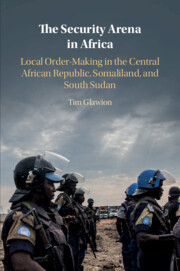 The Security Arena in Africa
The Security Arena in Africa Book contents
- The Security Arena in Africa
- The Security Arena in Africa
- Copyright page
- Contents
- Figures
- Maps
- Tables
- Boxes
- Acknowledgements
- Abbreviations
- Introduction
- 1 Ordering the Security Arena
- 2 National and Local Histories of Security
- 3 Creating Centres and Peripheries in the National Arena
- 4 Inner and Outer Circles of the Arena
- 5 Stable Ordering and Predictable Security
- 6 Fluid Ordering and Flexible Security
- 7 Mixing Ordering Forms
- 8 Embedding into and Detaching from the Arena
- Conclusion
- References
- Index
4 - Inner and Outer Circles of the Arena
Published online by Cambridge University Press: 16 January 2020
- The Security Arena in Africa
- The Security Arena in Africa
- Copyright page
- Contents
- Figures
- Maps
- Tables
- Boxes
- Acknowledgements
- Abbreviations
- Introduction
- 1 Ordering the Security Arena
- 2 National and Local Histories of Security
- 3 Creating Centres and Peripheries in the National Arena
- 4 Inner and Outer Circles of the Arena
- 5 Stable Ordering and Predictable Security
- 6 Fluid Ordering and Flexible Security
- 7 Mixing Ordering Forms
- 8 Embedding into and Detaching from the Arena
- Conclusion
- References
- Index
Summary
Chapter 4 focusses on the local level in order to examine the way different parts of arenas lend themselves to varying forms of ordering. Within an inner circle, actors engage more regularly, revealing themselves to one another and thereby creating pressure for a stable order. An outer circle is more illegible, diffuse, and widespread, which allows actors to use it as a refuge for fluid ordering. The shape of an arena is not a deterministic structure but rather one that actors deliberately mould to support the forms of ordering that benefit them most. This line of research ascertains (1) why, how, and where actors create the dividing line between an inner and outer circle (drawing the line), (2) why and how actors enter or leave an inner circle (crossing the line), and (3) what forms of interactions make a line obsolete between inner- and outer-circle actors (erasing the line).
- Type
- Chapter
- Information
- The Security Arena in AfricaLocal Order-Making in the Central African Republic, Somaliland, and South Sudan, pp. 111 - 141Publisher: Cambridge University PressPrint publication year: 2020
